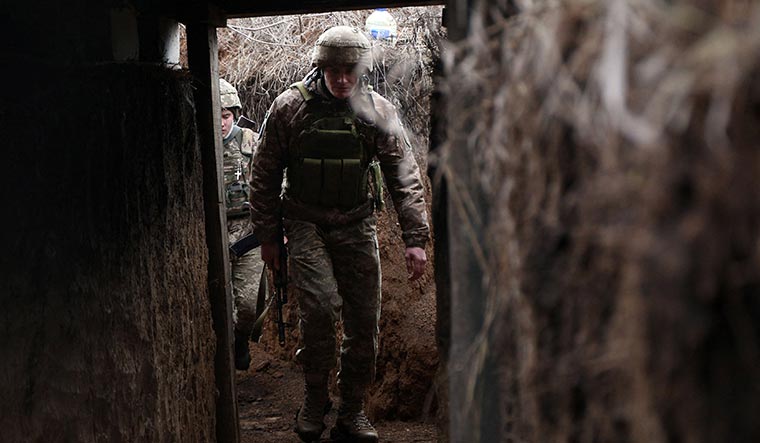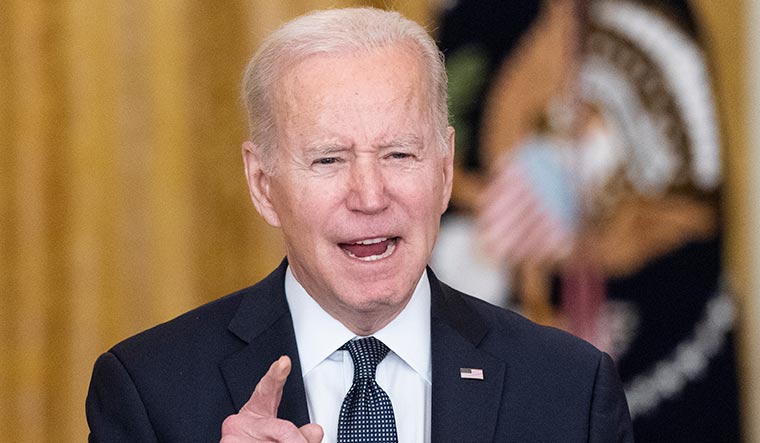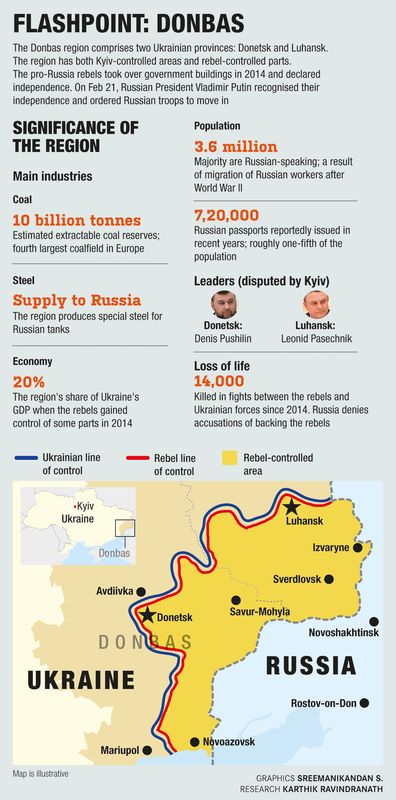In the second week of February, French President Emmanuel Macron and German Chancellor Olaf Scholz—two western leaders with a reasonably comfortable working relationship with Russian President Vladimir Putin—were in Moscow. Both, however, failed to dissuade Putin from escalating the threat against Ukraine.
What really made news after the two visits was the six-metre long, gold-plated table used for the meetings. Putin apparently wanted Macron and Scholz to do a Covid test, but both were in no mood to leave their DNA samples with the Russians. So, Putin brought out one of the longest tables in the Kremlin, to keep the two Europeans at a safe distance.
Back in August 2020, however, when the whole world was shut down because of the pandemic, Putin happily came out of his bio-bubble to receive one of his closest friends—Viktor Medvedchuk, a pro-Russian politician from Ukraine, his wife, Oksana, and their daughter Daria, who is also his godchild. The much publicised meeting with the Medvedchuks was Putin’s first public appearance after the pandemic started, and he posed for photos without a mask. Ukraine holds a very special place in Putin’s heart. For him, it is not a separate country, but a part of Russia itself.
THE POLITICS OF HISTORY
Putin explained his Ukraine obsession last year with a 7,000-word essay titled “On the Historical Unity of Russians and Ukrainians.” He claimed Russians and Ukrainians were “one people belonging to the eastern Slavic stock”, sharing the Ukrainian capital Kyiv as the mother of all Russia.
“We cannot live without each other,” wrote Putin. “Ukraine has been part of the single nation called Ancient Rus, which was the largest state in Europe, formed by Great Russia, Little Russia (Ukraine) and White Russia (Belarus). The three are inseparable with a single history, tradition, language and church. Ukraine’s trajectory away from Russia was orchestrated by agents of the west, observed Putin.
The obsession, however, is not just for historical reasons. A recent report published by the Carnegie Endowment for International Peace said while the historical claims about Ukraine were slightly far-fetched, the country possessed immense strategic value. “Ukraine is essential to Russian security for its size and population, its position between Russia and other major European powers and its role as the centrepiece of the imperial Russian and Soviet economies,” said the report.
Putin is mindful of the fact that it was the withdrawal of Ukraine that hastened the disintegration of the Soviet Union, which he said was the biggest geopolitical catastrophe of the 20th century. The Russian leadership—including the new republic’s first president, Boris Yeltsin—was hopeful of some sort of a union with Belarus and Ukraine. But at a hastily arranged meeting hosted by Belarus president Stanislav Shushkevich on December 8, 1991, Ukrainian president Leonid Kravchuk told Yeltsin that his country was walking out, signing the Soviet Union’s death warrant.
Once Putin succeeded Yeltsin as president, Ukraine turned into a key element of state policy. In the 2004 Ukrainian elections, he actively supported the pro-Russian candidate Viktor Yanukovych. The other leading candidate, Viktor Yushchenko, who had very clear western leanings, was poisoned by dioxin, a highly toxic chemical. Yushchenko survived with expert medical support, but was left with large abscesses and ugly boils on his face. Against all odds, Yushchenko defeated Yanukovych, and in the five years he was in power, he took Ukraine closer to the west, dealing Putin a major blow.
In April 2008, after NATO announced at its Bucharest summit that Ukraine and Georgia would eventually join the alliance, Putin was livid. “George, you have to understand that Ukraine is not even a country,” he warned US president George W. Bush.
A few weeks after Bucharest, Putin’s troops attacked and defeated Georgia in a short war, after Georgian leader Mikheil Saakashvili attempted to take control of the pro-Russian South Ossetia. Putin did not spare Ukraine as well, after Yanukovych (who won the 2010 elections) was ousted in a revolt caused by his refusal to sign a political association and free trade agreement with the European Union. Russia annexed Crimea in April 2014 and aided pro-Russian separatists to take control of the eastern Donbas region, consisting of the Donetsk and Lugansk republics.
While dealing with Ukraine, Putin is more tsar than commissar. He appears to be modelling himself after Alexander III, a reactionary tsar who reigned from 1881 to 1894, said Igor Torbakov, senior fellow at Uppsala University, Sweden. Alexander was not reluctant to use force to Russify Crimea. The Soviets, on the other hand, wanted only political control, and transferred Crimea to Ukraine in 1954. They also gave the country voting rights in the UN. No wonder Putin pointedly ignored the centennial of the 1917 Russian Revolution, but made a quick trip to Crimea to unveil a monument to Alexander. “Under this tsar, Russia’s influence and authority in the world was achieved not by yielding, but by a fair and unwavering firmness,” said Putin during the unveiling ceremony.
Ordinary Ukrainians, meanwhile, seem to be paying the price for Putin’s unwavering firmness. Kateryna Zavalna, a 25-year-old accountant from Kharkiv which is close to the Russian border, said Putin was planning to rebuild the Russian empire. “And we are suffering in the process. If the war starts, we will be among the first to be attacked,” said Zavalna.
REDRAWING THE EUROPEAN SECURITY MAP
Putin, who began his career as a KGB agent trained in the rigid Soviet school of thought, firmly believes in the primacy of Russia in the European theatre. There is no doubt in his mind that Russia, which brought Nazi Germany to its knees in World War II by sacrificing millions of its citizens, deserves to be a key pillar of the European security architecture. After the collapse of the Soviet Union, however, Russia was elbowed out and NATO became the key player in defining the contours of European security. The process was gradual, but painful, as an omnipotent America brushed away feeble protests by Mikhail Gorbachev and Yeltsin and imposed its will on Russia.
After the fall of the Berlin Wall, US secretary of state James Baker flew to Moscow in February 1990 and asked Gorbachev to withdraw the 2.5 lakh-strong Soviet military contingent from East Germany. In return, he promised that NATO would not shift “even an inch eastward”. Although the fine print of the withdrawal agreement omitted the promise—Baker himself claimed several years later that he was making a hypothetical bargain—Gorbachev acquiesced, as his country badly needed the $9 billion offered by Germany.
A few years later, US president Bill Clinton tempted Yeltsin with investments worth $4 billion and a membership in the G-7 to secure his approval for NATO’s expansion. Since then, 14 countries in eastern Europe have joined NATO, robbing Russia of its strategic depth.
Throughout the 1990s, Yeltsin was a regular visitor at the White House. Yeltsin, a compulsive drinker, was once so inebriated that he stepped out onto Pennsylvania Avenue in the middle of the night in his underwear, to get a pizza. The incident led to much mirth in the White House corridors, but the pain and shame it caused in Moscow was unfathomable.
The humiliation was complete in 1999, when NATO conducted a 78-day-long bombing mission in Kosovo without UN authorisation and completely ignoring Russian objections. As a member of Yeltsin’s core group, Putin had a ringside view of most of those crises and humiliations, which played a key role in shaping his attitude towards global politics.
On February 5, 1997, George Kennan, arguably the most famous Russian expert in US history, wrote in The New York Times that NATO’s expansion would be America’s most fateful foreign policy error in the entire post-Cold-War era. A decade later, US ambassador to Russia William Burns, who is now CIA director, said offering Ukraine NATO membership could present Russia with a crisis on its border in which it would be forced to intervene. Both proved eerily prescient.
“Putin knows that imperial Russia was successful in halting Napoleon’s march in 1812 and the Soviet Union could survive the German assault in 1941 because of its strategic depth. It is critical because the vast Russian landmass lacks natural geographic barriers like oceans, rivers, or mountains,” said Joshy M. Paul, international relations expert at the Delhi-based Centre for Air Power Studies. “Rolling back NATO’s influence in the Russian neighbourhood is a key aspect of reordering European security, and history and geography tell Putin that Ukraine is the right place to start. The recent pro-western geopolitical manoeuvres by Ukrainian President Volodymyr Zelenskyy has given Putin a welcome ruse to deploy nearly 1.9 lakh soldiers on the border.”
Putin was miffed by Zelenskyy’s decision to invite NATO forces for joint exercises and to deepen military cooperation. He was also alarmed by Ukraine’s purchase of the powerful Bayraktar drones from Turkey, which ensured the defeat of Russian ally Armenia in the 2020 war with Azerbaijan.
With tensions running high, Putin has presented a set of demands before the US. He wants a guarantee that Ukraine would never be a part of NATO and that the transatlantic alliance would stop all its expansion plans. He wants troops and weapons to be removed from countries that joined NATO after 1997 (meaning the entire eastern Europe) and also from areas where they could threaten Russia. Putin has also called for banning intermediate-range missiles and nuclear weapons in Europe. In response, the US said it would not abandon NATO’s “open-door”policy, but offered to evaluate Russian worries pragmatically.
US President Joe Biden has been a vocal critic of Putin—he once publicly called the Russian president a killer—and has warned repeatedly that a major invasion was imminent. After several such warnings by Biden and several senior members of his administration, Zelenskyy himself asked Biden to “calm down”, complaining that he was creating unnecessary panic. Many Ukranians, too, seem to agree.
Thamarai Pandian, who heads a pharmaceutical company in Kyiv, said it was the American deep state that seems eager to start another war after the US exit from Afghanistan. “Moreover, with his daily alarmist warnings, Biden has managed to brush aside frightening Covid statistics and also reports about the deepening partisan divide within the US,” said Pandian, a Ukraine resident for nearly three decades.
TIMING IS EVERYTHING
The manner in which Putin has timed the escalation is also significant. Despite a slew of geopolitical victories in the past couple of years, Putin’s popularity was affected by his inept handling of the pandemic and his violent crackdown against opposition leader Alexei Navalny. His popularity rating fell to its lowest level in over two decades as the president isolated himself in a bio-bubble and delegated responsibilities to regional governors. Acting tough on Ukraine is one of the easiest options for Putin to shore up his sagging ratings.
Another key factor that Putin has not missed is the ongoing churn in the existing global order. “He is unhappy about Russia getting side-lined and China becoming America’s predominant geopolitical rival, along with the Indo-Pacific turning into the primary theatre of global politics. The powerplay in Ukraine is Putin’s way of attracting America’s attention,” said Paul. “Putin has also cemented an alliance of convenience with China, which will come in handy in case of western sanctions.”
Yet, Putin remains wary of China. “He knows that China wants this war,” said Sanjeev Bhagat, the Kyiv-based director of a major pharmaceutical company. “It will give China access to the vast energy and land resources of Russia as it becomes weaker because of harsh sanctions.”
Putin, meanwhile, senses an apparent US weakness compared with a rising China. The chaotic withdrawal from Afghanistan, the civil war within the Democratic party, the bruising duel with the Republicans and the continuing perils of the pandemic have weakened Biden. His ratings are now below even Donald Trump’s numbers at a comparable point in his presidency.
Europe, too, has an unsettled look. Macron is preparing for elections; Scholz is trying to fill the outsized shoes of Angela Merkel; the scandal-tainted British Prime Minister Boris Johnson is struggling for political survival and Turkey is going through a crippling economic crisis. Europe also depends a lot on Russia for its energy needs. The Nord Stream II pipeline will add to this dependency and will take Ukraine out of the equation as a transit country.
Putin has had a couple of good years as far as relations with Russia’s neighbours are concerned. Georgia has been tamed, it even jailed former president Saakashvili, one of Putin’s bitter rivals, who has been serving as head of Ukraine’s Executive Reform Committee. In Kazakhstan, Moscow stepped in to quell anti-government protests. Armenia, which was trying to plot an independent foreign policy, saw most of the Nagorno-Karabakh territory under its control for three decades, being taken over by Azerbaijan under Putin’s tacit nod. In Belarus, wily autocrat Aleksandr Lukashenko, whose occasional overtures towards the west had angered Putin in the past, is back in the Russian camp after getting rattled by protests against his government.
The rising oil prices have strengthened Putin’s hands further. The price at which Russia could balance its budget is around $40 a barrel. Crude prices crossed $90 a barrel in January for the first time in seven years. With the rising energy prices, Putin has built a war chest of $620 billion in foreign reserves, giving him the liberty of modernising his armed forces, performing extensive military exercises, developing new weapon systems, rewarding his allies, diversifying his investments and, of course, preparing for a war in his backyard.
THE ENDGAME
Putin hopes to bring America to the negotiating table, launching the groundwork for possible nuclear weapons’ treaties and getting Biden to convince Zelenskyy about implementing the Minsk II accords, but on Russia’s terms. On February 19, Putin oversaw testing of nuclear-capable hypersonic missiles, intended as a message to Biden and Zelenskyy. Two days later, he recognised the independence of Donetsk and Luhansk and ordered Russian troops to move into the two provinces. In an emotional speech, Putin even blamed Soviet stalwarts Vladimir Lenin, Joseph Stalin and Nikita Khrushchev for gifting Russian territories to Ukraine, and indicated that he might take action beyond just recognising the rebel republics.
The Minsk accord, signed in February 2015, calls for the withdrawal of foreign troops and mercenaries from Donetsk and Luhansk. It also calls for more autonomy for the two regions and also for conducting elections there. Russia wants political reforms first, as it would give Donetsk and Luhansk veto power in Ukraine’s relations with NATO. The Zelenskyy government, however, wants to take control of the region before starting the political process. Russia’s recognition of the region’s independence and sending in troops have put more pressure on Zelenskyy. The US, meanwhile, criticised the Kremlin’s recognition of the two regions and announced that sanctions would follow.
“For Ukraine, the future of Donetsk and Luhansk is quite a painful issue,” said Viktoriia Ivanchenko, an analyst from Donetsk, who is with the Russian Foreign Trade Academy. “Donetsk used to be one of the leading and richest regions in Ukraine. But after being a conflict zone for more than seven years, things have changed and people are leaving the region.”
With Putin ordering his troops into the breakaway republics, Ukrainians fear the worst. “There are several scenarios of possible military action, including a full-scale invasion,” said Oleksandr Sakharenko, a public affairs expert from Kyiv. “After Donetsk and Luhansk, the city of Mariupol is under the biggest threat. Also, the large cities of Kharkiv in the northeast, Dnipro in the centre and Odessa in the south are possible targets. In the worst-case scenario, Kyiv, too, may be attacked.”
When Putin annexed Crimea in 2014, he became the first leader since Stalin to expand Russia’s territory. Some of the skills he picked up when he was with a street gang in the 1960s Leningrad seem to be helping Putin even now. Back then, a short and skinny Putin somehow managed to outpunch markedly heftier opponents. “The Leningrad street taught me a rule: if a fight is inevitable, you have to throw the first punch,”said Putin. His policy on Ukraine seems to be modelled on that lesson, and the response from the west could make or mar his legacy and Europe’s destiny.





